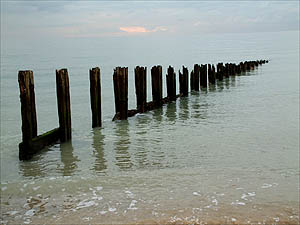Difference between revisions of "Resilience and resistance"
Matthijs Vos (talk | contribs) (→Resistance to changes in abiotic and biotic factors) |
Matthijs Vos (talk | contribs) |
||
| Line 3: | Line 3: | ||
Coastal and marine [[ecosystems]] are constantly changing and can respond to environmental disturbances both slowly or quickly. | Coastal and marine [[ecosystems]] are constantly changing and can respond to environmental disturbances both slowly or quickly. | ||
| − | Resistance is the capacity of an [[ecosystem]] to remain relatively unchanged when confronted by a disturbance, while [[resilience]] | + | Resistance is the capacity of an [[ecosystem]] to remain relatively unchanged when confronted by a disturbance, while [[resilience]] has been defined in different ways: it can be a measure for the speed at which an [[ecosystem]] returns to its former state following a disturbance. It is also |
==Introduction== | ==Introduction== | ||
[[Image:Uses1.jpg|thumb|left|]]Coastal systems are naturally resilient. 'Hard' rock coasts resist the impact of [[waves]], [[tides]] and storms, whereas 'soft' rocks tend to erode and sedimentary systems respond by moving landward or seaward depending on the balance between erosional and accretional forces acting upon them. This article will discuss the implications of this in relation to coastal management. In particular it will argue that too often human intervention (land claim, infrastructure etc.) has helped to create 'problem' areas where erosion is considered to be a threat to the socio-economic fabric of an area rather than an opportunity for environmental sustainability or restoration. | [[Image:Uses1.jpg|thumb|left|]]Coastal systems are naturally resilient. 'Hard' rock coasts resist the impact of [[waves]], [[tides]] and storms, whereas 'soft' rocks tend to erode and sedimentary systems respond by moving landward or seaward depending on the balance between erosional and accretional forces acting upon them. This article will discuss the implications of this in relation to coastal management. In particular it will argue that too often human intervention (land claim, infrastructure etc.) has helped to create 'problem' areas where erosion is considered to be a threat to the socio-economic fabric of an area rather than an opportunity for environmental sustainability or restoration. | ||
Revision as of 11:59, 12 March 2009

|
Coastal and marine ecosystems are constantly changing and can respond to environmental disturbances both slowly or quickly. Resistance is the capacity of an ecosystem to remain relatively unchanged when confronted by a disturbance, while resilience has been defined in different ways: it can be a measure for the speed at which an ecosystem returns to its former state following a disturbance. It is also
Contents
Introduction
Coastal systems are naturally resilient. 'Hard' rock coasts resist the impact of waves, tides and storms, whereas 'soft' rocks tend to erode and sedimentary systems respond by moving landward or seaward depending on the balance between erosional and accretional forces acting upon them. This article will discuss the implications of this in relation to coastal management. In particular it will argue that too often human intervention (land claim, infrastructure etc.) has helped to create 'problem' areas where erosion is considered to be a threat to the socio-economic fabric of an area rather than an opportunity for environmental sustainability or restoration.Biodiversity allows the ecosystems to adapt to changing conditions. Humans, however, have acted to increase the rate of change and consequently, it will be a great challenge for the marine environment to adapt rapidly enough in the future. These changes have been induced through pollution, fishing, sediment deposition and alteration of the global climate. Without genetic diversity, natural selection cannot occur and natural selection is limited, then adaptation is impossible. It is evident that the preservation of biodiversity and, more specifically, genetic diversity is of paramount importance for successful adaptation to our rapidly changing environments.
Resilience through re-colonization
Resistance to changes in abiotic and biotic factors
Community composition and ecosystem function may change very little under environmental change when the organisms can acclimate to such change or tolerate it for some time (when the change is only temporary). However, all organisms have bounds to what they can temporarily or permanently tolerate, and when change exceeds some of these limits, the community compostion and ecosystem functioning is likely to change.
It is unlikely that communities can be resistant to continuous gradual change, such as global warming. Acclimation and phenotypic plasticity do not suffice to maintain the system as it is. Genetic adaptation could allow community members to track such abiotic environmental change, but it is more likely that the area where the community is functioning will be invaded by species that function well at higher temperatures. The original species will thus have to deal with new competitors and predators, in addition to the changed abiotic factor. To some extent the original community can track the preferred temperature range, by moving spatially to greater depths or to alternative gepgraphic areas. But these new areas are likely to differe in other ecological aspects such as water pressure, light climate and perhaps speeds of water flow etc.
Adaptation and the consequences of mortality at different trophic levels
References
Abrams, P.A & Vos, M. 2003. Adaptation, density dependence and the responses of trophic level abundances to mortality. Evolutionary Ecology Research 5:1113-1132.
DeAngelis, D. L. 1992. Dynamics of Nutrient Cycling and Food Webs. Chapman and Hall, London.
Rossi, F., Vos, M. & Middelburg, J.J. 2009. Species identity, diversity and microbial carbon flow in reassembling macrobenthic communities. Oikos, Early View, (January issue).
See Also
Resilience as a criterion in marine biological evaluation
Please note that others may also have edited the contents of this article.
|
